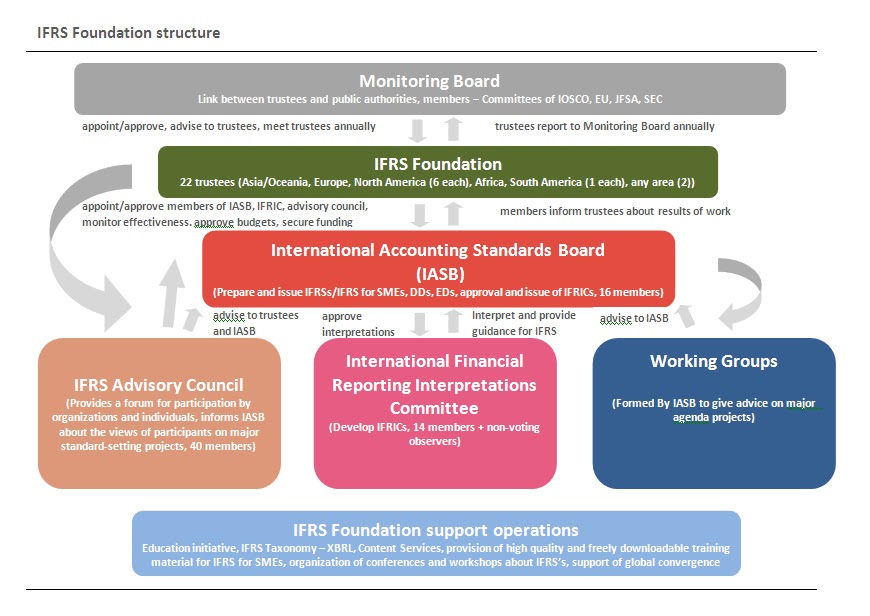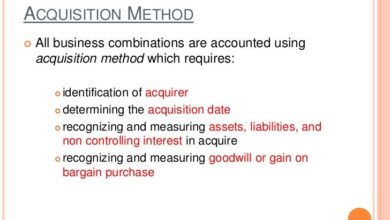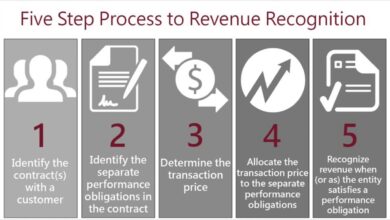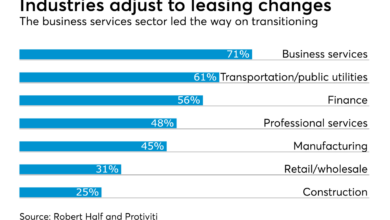
IASB Consults to Improve Acquisition Information
IASB consults to improve acquisitions information, prompting a critical review of how companies disclose acquisition details. This initiative aims to enhance transparency and comparability, a move that could significantly impact investor confidence and market efficiency. The proposed changes will likely reshape financial reporting processes, prompting a thorough analysis of their potential benefits and drawbacks.
This consultation delves into the details of the IASB’s proposed improvements, examining the potential impacts on various stakeholders, including investors, companies, and regulators. It also explores potential implementation challenges and alternative approaches, offering a comprehensive view of the complexities involved.
Understanding IASB Consultations on Acquisitions Information

The International Accounting Standards Board (IASB) is constantly striving to improve financial reporting, particularly for complex transactions like acquisitions. Recent consultations have focused on enhancing the disclosures surrounding acquisitions, aiming to provide investors and other stakeholders with clearer and more comprehensive information. These improvements are designed to facilitate better decision-making and promote greater transparency in the financial markets.
Summary of Recent IASB Consultations
The IASB has initiated several consultations in recent years regarding the disclosure requirements for acquisitions. These consultations have explored various aspects of acquisition information, aiming to provide a more holistic and understandable picture of the transaction for investors. These consultations represent an ongoing effort to improve the clarity and comparability of financial reporting for acquisitions.
Key Areas of Focus in Consultations
The consultations have concentrated on several crucial areas, including the presentation of acquisition costs, the disclosure of contingent liabilities, and the integration of acquired entities’ financial information. The proposed changes aim to provide a more accurate reflection of the acquisition’s financial impact and associated risks. This is crucial for investors to assess the long-term implications of the transaction.
Proposed Changes in Disclosure Requirements
The IASB’s proposals often involve expanding the scope of information disclosed. For example, there might be a requirement to include a more detailed breakdown of acquisition costs, potentially separating intangible assets from tangible assets. Additionally, the consultations frequently propose more granular disclosures related to contingent liabilities arising from the acquisition, providing a clearer picture of potential future obligations.
The integration of acquired entities’ financial information is another focus area, aiming for a more consistent and comparable presentation of post-acquisition performance.
Rationale Behind the Proposed Improvements
The IASB justifies these improvements by highlighting the need for greater transparency and comparability in financial reporting. Improved disclosures are expected to reduce information asymmetry between companies and investors. The enhanced clarity in acquisition disclosures will ultimately benefit investors, allowing them to make more informed investment decisions. Better understanding of the transaction’s impact on the acquirer is a core objective.
Table of Consultation Documents
| Consultation Document | Relevant Sections | Date |
|---|---|---|
| Exposure Draft: Accounting for Acquisitions | Sections 10-15, 20-25 | October 2023 |
| Consultation Paper: Accounting for Goodwill | Sections 30-40, 50-55 | December 2022 |
| Discussion Paper: Impairment of Acquired Assets | Sections 60-70, 80-85 | March 2023 |
Impact Analysis of Proposed Changes: Iasb Consults To Improve Acquisitions Information
The IASB’s proposed improvements to acquisition information aim to enhance transparency and comparability, ultimately benefiting investors and stakeholders. However, any significant shift in accounting standards necessitates a thorough assessment of both the positive and negative consequences. This analysis explores the potential effects of these changes on various stakeholders, highlighting both the advantages and drawbacks.These changes represent a crucial step towards a more nuanced and reliable understanding of acquisitions.
By carefully considering the potential impacts, we can better gauge the long-term implications and work towards a system that serves the needs of all parties involved.
Potential Positive Impacts on Transparency and Comparability
The proposed changes strive to increase the transparency and comparability of acquisition information by providing a more standardized and detailed view of the acquired assets and liabilities. This will allow investors and analysts to gain a clearer picture of the financial health and potential of the acquiring company. Improved disclosure of contingent liabilities, for example, will enable stakeholders to make more informed decisions, leading to a more efficient allocation of capital.
- Enhanced clarity in identifying hidden risks or opportunities within an acquisition, enabling a more accurate assessment of the overall transaction value. This will reduce the likelihood of unforeseen financial difficulties in the future.
- Greater comparability across different acquisition transactions. This is achieved through standardized disclosures, facilitating the evaluation of various acquisition strategies and outcomes, thereby reducing potential misinterpretations and inaccuracies.
- Increased investor confidence due to greater transparency and accuracy. This leads to a more stable and efficient capital market.
Potential Negative Impacts on Stakeholders
While the proposed changes aim to improve transparency, there are potential negative impacts that must be considered. The added complexity in financial reporting could increase administrative burdens on companies, potentially affecting their operational efficiency.
- Increased complexity in financial reporting processes, demanding additional resources and expertise. This could lead to higher costs for companies, particularly smaller ones, and could potentially affect their competitiveness.
- Potential for increased litigation risk if the new standards are not properly understood or applied, potentially leading to disputes with investors or regulatory bodies. This can cause financial and reputational damage to the acquiring company.
- Disincentive for certain types of acquisitions if the new disclosure requirements become too burdensome. This could negatively impact the acquisition market and limit the potential for mergers and acquisitions in certain sectors.
Comparison with Existing Standards and Practices
The proposed changes represent a significant departure from some existing accounting standards and practices. A comparison will highlight the key differences and potential implications for current reporting.
- Existing standards often lack detailed disclosure requirements for contingent liabilities. The proposed changes aim to remedy this by demanding greater clarity on potential future obligations.
- Many current practices rely on industry-specific or company-specific interpretations, leading to inconsistencies in reporting. The proposed standardization will increase comparability across various sectors.
Impact on Financial Reporting Processes
The proposed changes will require companies involved in acquisitions to adapt their financial reporting processes. This will necessitate significant changes in internal procedures and potentially lead to adjustments in software or systems.
- Companies will need to implement new internal controls and procedures for gathering, verifying, and reporting acquisition-related information. This necessitates a thorough understanding of the new requirements and an adjustment of the accounting systems.
- Companies may require additional training for their financial reporting staff to ensure accurate and compliant reporting. This could be a significant cost.
Potential Effects on Stakeholder Groups
The table below summarizes the potential effects of the proposed changes on various stakeholder groups.
| Stakeholder Group | Potential Positive Impacts | Potential Negative Impacts |
|---|---|---|
| Companies | Increased transparency, improved decision-making | Increased reporting burden, potential litigation risk |
| Investors | Enhanced information, improved investment decisions | Potential complexity in analyzing information, potential delays in decision-making |
| Analysts | Improved data for analysis, better comparability | Increased complexity in data analysis, potential delays in analysis |
| Regulators | Enhanced oversight, improved market integrity | Potential for increased workload, potential for disputes |
Analysis of Stakeholder Perspectives
Decoding the diverse viewpoints on proposed changes to acquisition information is crucial for the IASB’s success. Understanding the motivations, concerns, and priorities of various stakeholders – investors, companies, and regulators – is essential to crafting effective and impactful reforms. This analysis delves into the nuances of these perspectives, highlighting the arguments for and against the proposed enhancements.Different stakeholders have varying degrees of influence and vested interest in the outcome of these changes.
The proposed improvements, while aiming to enhance transparency and comparability, may potentially impose costs and complexities on different groups, thereby shaping their perspectives. Identifying these contrasting viewpoints allows for a more balanced and comprehensive evaluation of the proposed changes.
Investor Perspectives
Investors, particularly institutional investors, are driven by maximizing returns and minimizing risks. They need reliable and comparable information to assess investment opportunities and make informed decisions. Arguments in favor of the proposed changes often center on increased transparency and comparability of acquisition information, which directly translates into improved investment decision-making. Conversely, concerns might arise regarding the potential increase in the complexity of financial reporting, which could potentially deter smaller investors and increase compliance costs for companies.
The key priority for investors is the preservation of a balance between informative disclosure and the burden of compliance.
Company Perspectives
Companies, especially those engaging in acquisitions, have a vested interest in the efficiency and practicality of the reporting requirements. Arguments in favor of improvements typically emphasize the benefits of improved investor confidence and market valuations. However, the potential costs associated with adapting to new reporting standards and the time and resources needed for implementation are key concerns. The priority for companies often lies in the balance between the benefits of enhanced transparency and the practical considerations of reporting complexity.
Regulator Perspectives, Iasb consults to improve acquisitions information
Regulators play a crucial role in ensuring fair and equitable markets. They aim to maintain market integrity and investor confidence. Arguments in favor of the proposed changes often highlight improved transparency and market efficiency. Key concerns, however, may center on the potential impact on smaller companies and the practical challenges of enforcement. Regulators prioritize a balance between ensuring market integrity and not imposing undue burdens on market participants.
Stakeholder Viewpoints Summary
| Interest Group | Perspective | Arguments For | Arguments Against | Key Priorities |
|---|---|---|---|---|
| Investors | Seeking more transparent and comparable acquisition information. | Improved investment decision-making, reduced information asymmetry. | Increased reporting complexity, potentially higher compliance costs. | Balance between information disclosure and compliance burden. |
| Companies | Concerned about the practical implications of new reporting standards. | Enhanced investor confidence, potentially higher valuations. | Increased reporting complexity, compliance costs, resource demands. | Balance between enhanced transparency and practical reporting considerations. |
| Regulators | Aiming for fair and equitable markets with enhanced transparency. | Improved market efficiency, investor confidence, reduced information asymmetry. | Potential burden on smaller companies, practical challenges of enforcement. | Balance between market integrity and manageable burden on market participants. |
Potential Implementation Challenges

Navigating the intricacies of new accounting standards, particularly those related to acquisitions, often presents significant hurdles for businesses. Companies face a range of practical challenges, from resource allocation to training and data system adjustments. Successful implementation hinges on a thorough understanding of these obstacles and a proactive approach to mitigating them.
Resource Allocation and Expertise
Adapting to revised acquisition information standards requires substantial resources, both financial and human. Companies need to assess their existing capabilities and identify potential gaps in expertise. This may involve hiring new personnel with specialized knowledge in the new standards, or investing in training programs for existing staff. For example, a smaller company might need to outsource certain tasks to retain core competencies while ensuring compliance.
Training Requirements for Personnel
Implementing new acquisition information standards necessitates a comprehensive training program for all personnel involved in financial reporting. This includes accountants, auditors, and other stakeholders who handle financial transactions and reporting. Training should cover the nuances of the new standards, including specific examples and practical application scenarios. A tailored approach, addressing the unique needs and roles of each department, is crucial for effective knowledge transfer.
Data Management and System Updates
Implementing new acquisition information standards often necessitates substantial data management and system updates. Existing accounting software may need modifications to accommodate the new data fields and reporting requirements. This can be a complex and time-consuming process, potentially involving significant IT resources. Careful planning and phased implementation can help manage the transition and minimize disruptions to ongoing operations. Companies should meticulously document their existing data structures and processes to ensure a smooth migration.
For example, if the existing database doesn’t accommodate the new detailed acquisition information, a migration strategy to a more adaptable system might be needed.
Compliance Procedure
A well-defined procedure is essential for ensuring companies adhere to the new acquisition information requirements. This should include a clear roadmap for implementation, including timelines, responsibilities, and checkpoints. Internal audits and quality assurance checks should be incorporated into the procedure to monitor compliance. The procedure should Artikel specific steps for data validation, reporting, and documentation to guarantee accuracy and consistency.
This procedure should be reviewed and updated regularly to reflect any changes in the standards or business operations.
| Step | Description |
|---|---|
| 1. Assessment | Evaluate current processes, identify gaps, and assess resource needs. |
| 2. Training | Develop and deliver comprehensive training programs to all relevant personnel. |
| 3. System Updates | Modify accounting software and data management systems to meet the new standards. |
| 4. Data Migration | Migrate data to ensure compatibility with the updated systems and standards. |
| 5. Compliance Monitoring | Establish internal audit procedures to monitor ongoing compliance. |
Alternative Approaches and Solutions
The IASB’s proposed changes to acquisition information aim to enhance transparency and comparability. However, alternative approaches could achieve similar objectives without the potential complexities of direct implementation. Exploring these alternatives is crucial to ensure the most effective and efficient solution for stakeholders.Alternative models for improving acquisition information can be more tailored to specific needs and circumstances. By understanding the advantages and disadvantages of each approach, businesses and regulators can choose the solution that best fits their context.
Alternative Models for Enhancing Acquisition Information
Different approaches to improving acquisition information exist, each with its own set of advantages and disadvantages. These models can be categorized into voluntary disclosure standards, enhanced due diligence frameworks, and standardized reporting templates.
- Voluntary Disclosure Standards: Companies can be encouraged to disclose more comprehensive information on acquisitions through the establishment of voluntary disclosure standards. These standards can be developed by industry associations or professional bodies, providing a framework for consistent reporting without the strict enforcement mechanisms of mandatory regulations. This approach allows for flexibility and adaptability to evolving circumstances. A major advantage is the potential for faster adoption compared to mandatory changes.
However, the effectiveness of voluntary standards relies heavily on the willingness of companies to comply and the credibility of the standards themselves.
- Enhanced Due Diligence Frameworks: Implementing stricter due diligence procedures for acquisitions can help uncover hidden risks and liabilities. This involves a more comprehensive review of target companies’ financial and operational aspects. By incorporating more detailed financial projections, environmental impact assessments, and legal audits, these enhanced frameworks can provide more comprehensive insights into acquisition opportunities. This approach often requires significant resources and expertise, but it can reduce the risk of unforeseen issues post-acquisition.
The challenge lies in the potential for increased costs and the variability of the quality of due diligence performed.
- Standardized Reporting Templates: The development of standardized reporting templates can facilitate a structured approach to presenting acquisition information. These templates can be tailored for different types of acquisitions, providing a consistent format for reporting key financial and operational data. A major benefit is the ease of comparison and analysis of acquisition data across different companies and sectors. However, such standardization may not adequately capture the unique characteristics of each acquisition and may limit the flexibility to present nuanced information.
Comparing Proposed and Alternative Approaches
A comparison table highlighting the key differences between the proposed IASB changes and the alternative approaches can aid in decision-making.
| Feature | Proposed IASB Changes | Voluntary Disclosure Standards | Enhanced Due Diligence Frameworks | Standardized Reporting Templates |
|---|---|---|---|---|
| Mandate | Mandatory | Voluntary | Can be mandatory or voluntary | Can be mandatory or voluntary |
| Enforcement | Regulator-driven | Self-regulation | Can be regulator-driven or self-driven | Can be regulator-driven or self-driven |
| Flexibility | Limited | High | Medium to High | Medium |
| Cost | Potentially high for implementation | Potentially lower | Potentially high for implementation | Potentially moderate |
| Time to Implementation | Longer | Shorter | Variable | Variable |
Illustrative Examples of Improved Acquisition Information
Improving the transparency and clarity of acquisition information in financial statements is crucial for investors and other stakeholders. Current disclosures often lack the detail needed to fully understand the complexities of an acquisition, leading to potential misinterpretations and concerns. Enhanced disclosures, as Artikeld below, will address these shortcomings and provide a more comprehensive picture of the acquisition’s impact.
Improved Presentation of Acquisition Costs
Current practices often fail to adequately distinguish between various acquisition components, making it difficult to assess the true value and potential risks. Enhanced disclosures will break down acquisition costs into clear categories, including purchase price, transaction fees, integration costs, and contingent liabilities. This granular breakdown allows investors to better evaluate the overall cost structure and potential future obligations. Examples of specific categories for improved disclosures include:
- Purchase Price Allocation: A detailed schedule of the allocation of the purchase price to identifiable assets, liabilities, and goodwill. This will include supporting rationale and methodologies used to determine the allocation, addressing concerns about potential overvaluation or undervaluation of assets.
- Transaction Costs: A clear breakdown of legal, advisory, and other transaction fees. This ensures transparency about the overall cost of the acquisition beyond the purchase price.
- Integration Costs: Explicit disclosure of the estimated costs associated with integrating the acquired entity into the reporting entity’s operations. This enables investors to better understand the potential financial strain and operational challenges associated with the integration process. This addresses stakeholder concerns about the potential for underestimation of integration costs.
- Contingent Liabilities: A comprehensive list of potential future obligations arising from the acquisition, such as pending litigation or warranty claims. The disclosure should include the nature of the contingency, estimated likelihood of occurrence, and potential financial impact. This enhances transparency about potential future risks and obligations.
Enhanced Goodwill and Intangible Asset Disclosures
Detailed disclosures regarding goodwill and intangible assets are vital to understanding the strategic rationale behind an acquisition. Current disclosures are often too general, lacking specific information about the acquired entity’s future potential and the supporting evidence. Improved disclosures will address these shortcomings and provide a more comprehensive picture of the acquisition’s long-term implications.
- Goodwill Impairment Testing: Clear documentation of the methods used to assess goodwill impairment, including the assumptions and methodologies used. This addresses stakeholder concerns about the objectivity and thoroughness of the testing process.
- Intangible Assets: Individual descriptions of significant intangible assets acquired, including the estimated useful lives and any amortization schedules. This provides investors with a more granular understanding of the long-term value proposition of the acquired intangible assets.
- Valuation Methodologies: Detailed explanations of the methodologies used to value acquired intangible assets, such as customer lists, trademarks, and patents. This demonstrates the transparency and objectivity of the valuation process.
Illustrative Table of Improved Disclosures
| Scenario | Current Disclosure | Improved Disclosure |
|---|---|---|
| Acquisition of a software company | Purchase price only | Purchase price, transaction fees, integration costs (development team training), goodwill impairment testing (detailed explanation of methodology), intangible asset details (customer lists, intellectual property). |
| Acquisition of a retail chain | Purchase price, general transaction costs | Purchase price, transaction fees (legal, advisory, etc.), integration costs (staff training, store refurbishment), contingent liabilities (pending legal cases related to store leases). |
| Acquisition of a manufacturing facility | Purchase price, transaction costs | Purchase price, transaction fees, integration costs (equipment re-tooling), contingent liabilities (environmental remediation), intangible assets (brand recognition). |
International Comparisons of Acquisition Reporting Practices
Different countries have varying approaches to reporting acquisitions, reflecting diverse legal frameworks, accounting standards, and cultural contexts. Understanding these differences is crucial for multinational corporations and investors navigating the global landscape of mergers and acquisitions. This exploration examines the nuances of acquisition reporting across jurisdictions, highlighting both strengths and weaknesses of various methodologies.
Comparative Analysis of Acquisition Reporting Standards
Different countries have unique approaches to recording and disclosing acquisition-related information. This stems from varying legal requirements and the influence of specific accounting standards. This section will compare and contrast these practices to illuminate the differences and similarities in how acquisitions are reported.
- United States: The US predominantly utilizes Generally Accepted Accounting Principles (GAAP) for reporting acquisitions. This framework often focuses on the fair value of acquired assets and liabilities, resulting in detailed disclosures. Companies are required to provide comprehensive information on the acquisition’s rationale, financial implications, and potential synergies.
- United Kingdom: The UK follows International Financial Reporting Standards (IFRS), which shares some commonalities with GAAP but also has its own specific nuances. The focus on fair value measurement is evident in UK acquisition reporting. Detailed disclosures are typically required to maintain transparency.
- European Union: EU member states often adopt IFRS, but national laws can influence specific reporting requirements. This creates a diverse landscape with varying degrees of detail and disclosure, depending on the specific country within the EU.
- Japan: Japan utilizes its own set of accounting standards, which may differ significantly from IFRS and GAAP in terms of presentation and disclosure. There might be unique considerations regarding cultural factors and the disclosure of sensitivities related to acquisitions.
- China: China’s accounting standards have evolved over time and may not always align perfectly with international standards. Disclosure requirements might be influenced by government regulations and the unique economic context of China.
Benefits and Drawbacks of Different Approaches
Each country’s approach to acquisition reporting has its own advantages and disadvantages. The effectiveness of these systems depends on the specific context and objectives.
- Comprehensive Disclosure (e.g., US): Detailed disclosures can provide investors with a clearer understanding of the acquisition’s financial impact, potentially leading to more informed investment decisions. However, excessive detail might also be cumbersome and add to reporting costs.
- Conciseness and Efficiency (e.g., Some Asian Countries): A streamlined approach might facilitate quicker reporting processes and potentially reduce compliance costs. However, it could also result in less transparency and a lack of detailed information for investors.
Identification of Best Practices
Certain countries exhibit best practices in acquisition reporting. These practices emphasize transparency, consistency, and comparability of information across different transactions.
- Transparency and Clarity: Clear and concise disclosures, easy to understand by stakeholders, are crucial for facilitating informed decision-making.
- Consistency and Comparability: Consistent application of accounting principles across various acquisitions enhances comparability and facilitates trend analysis.
- Fair Value Measurement: Accurate fair value measurements are essential for ensuring the financial statements accurately reflect the transaction’s impact.
Illustrative Examples of Best Practices
Specific examples of best practices from different countries can provide further insight. For instance, the US’s focus on fair value measurement in GAAP, coupled with detailed disclosures, can be considered a best practice in providing comprehensive information to stakeholders.
- Example 1 (US): Detailed disclosure of acquisition synergies, anticipated cost savings, and revenue enhancement.
- Example 2 (UK): Clear presentation of the acquired company’s financial performance, enabling investors to analyze the integration of the acquisition into the reporting entity.
Comparison Table of Acquisition Reporting Standards
| Country | Reporting Standards | Disclosure Requirements | Fair Value Measurement | Overall Transparency |
|---|---|---|---|---|
| United States | GAAP | Detailed | Emphasis | High |
| United Kingdom | IFRS | Detailed | Emphasis | High |
| Japan | Japanese GAAP | Variable | Variable | Medium |
| China | Chinese GAAP | Variable | Variable | Medium |
| EU (various) | IFRS (mostly) | Variable | Emphasis | Medium to High |
Final Review
In conclusion, the IASB’s consultation on improving acquisition information reveals a multifaceted issue with significant implications. Understanding the proposed changes, their potential impacts, and stakeholder perspectives is crucial for informed decision-making. The consultation process offers a unique opportunity to shape the future of acquisition reporting, ensuring greater transparency and comparability for investors and stakeholders alike.





